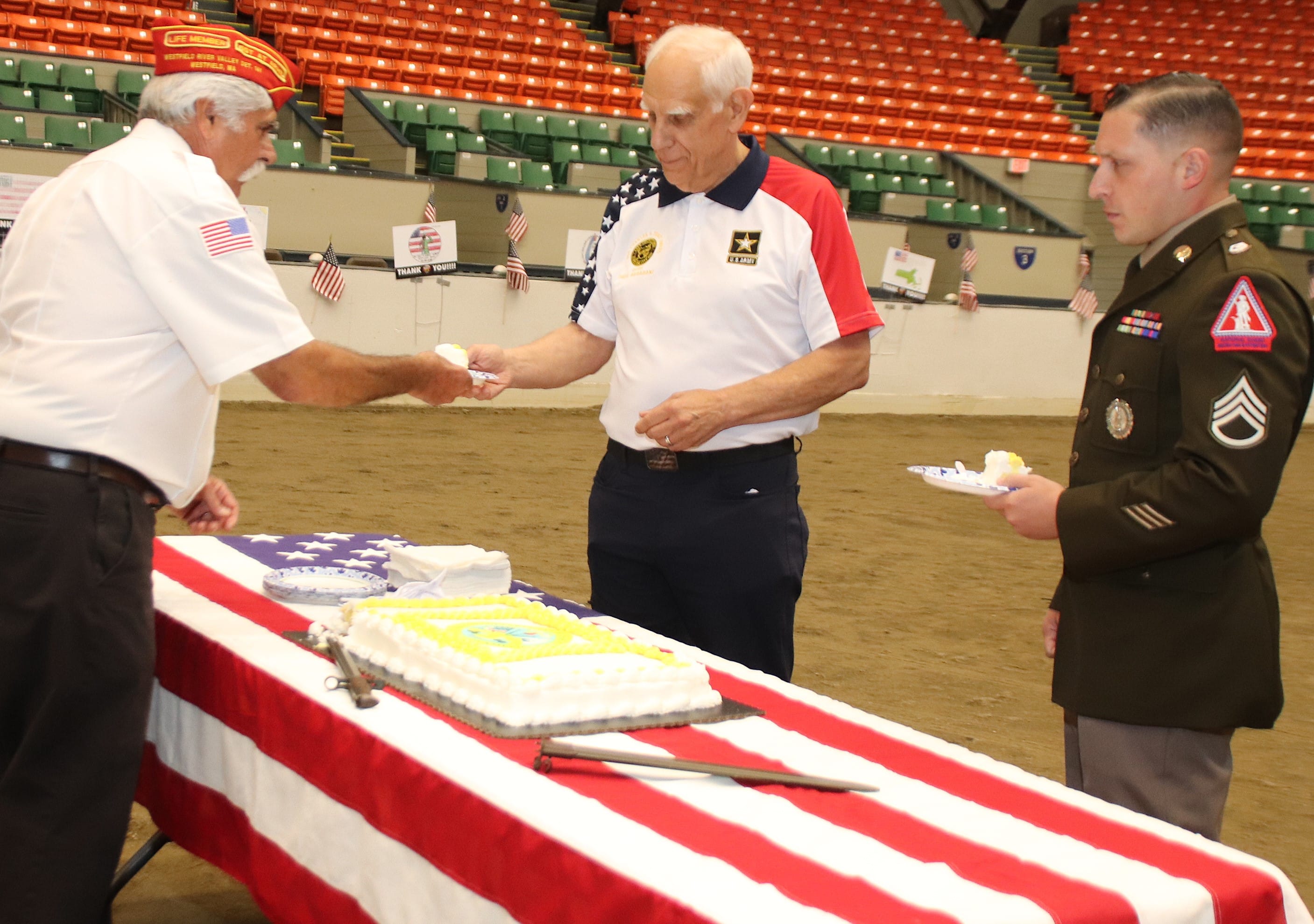Paul Barabani (center), the oldest Army vet at the “Bring a Veteran to School” program, and Staff Sgt. Jonathan Peloquin, the youngest vet in attendance (right), cut a birthday cake that honored the founding of the U.S. Army in a special ceremony that symbolizes the passing of knowledge and experience and leadership from one generation of soldiers to the next. At left is Aldo Mancini, a member of the Agawam Veterans Council.
Reminder Publishing photo by Mike Lydick
AGAWAM — Sixth grade teacher Kathleen Goyette-Jediny has coordinated a “Bring a Veteran to School” program at Agawam’s Roberta Doering Middle School for more than a decade. The program, usually presented near Veterans Day, connects young people with veterans.
Unable to have the program last November because of the presidential election, Goyette-Jediny moved it to June 13 to coincide with the celebration of the 250th birthday of the U.S. Army on June 14. She also changed the location to the Coliseum building at the Eastern States Exposition in West Springfield.
Moving to a larger venue allowed the school’s nearly 600 fifth and sixth graders to experience the program together instead of in separate assemblies in the school’s auditorium. Some students also had the opportunity to participate in this year’s program.
Dozens of students held small American flags and formed a “pathway of flag honors” for the nearly 50 local veterans attending the program as they walked to their seats in the center of the Coliseum. Local officials also participated in the program as speakers and presenters.
Although the two-hour program celebrated the army’s birthday, the focus was on the service, traditions and the important role all military veterans play in helping to keep the country safe. The program not only honored veterans, but also served as a history lesson for students.
Several short videos helped reinforce messages from speakers.
Agawam Mayor Christopher Johnson kicked off the event by speaking about the importance of veterans connecting with students in the community. Johnson recalled that he and his best friend grew up listening to stories from their fathers — funny ones when they were young and serious ones when they were older — who served in World War II.
“What it left with me and my friend was, number one, a deep-seated gratitude for their service and for the service of all veterans, and number two, an appreciation for public service in general,” said Johnson. “So, thank you to the veterans — and please share your stories, whether they’re funny or serious, with the children. They need to know what the cost of freedom is.”
Paul Barabani, former president of the Friends of the Massachusetts Veterans Memorial Cemetery at Agawam, spoke about the history of the Army — including two Agawam connections.
When the Continental Congress created the army in spring 1775, George Washington was appointed the first commander. Washington, who was in Philadelphia, traveled to Boston by stagecoach to assume command of troops, which included the Massachusetts National Guard, formed in 1639.
“His stagecoach rode through Agawam on its way to Boston. There’s a plaque at the veterans cemetery that says George Washington passed through here on June, 3, 1775,” said Barabani.
The other Agawam connection to the Army is Gen. Creighton Abrams. He graduated from Agawam High School in 1931, later attended West Point and was a tank commander with Gen. George Patton during World War II. The Army’s main battle tank, the MI Abrams, was put into service in 1980 and it is still being used. Abrams went on to serve in Korea and Vietnam and then became chief of staff for the U.S. Army.
One of the advantages of using the Coliseum for the program is that it provides a way to have presentations that students couldn’t see during a school assembly, such as the riderless horse. A powerful symbol used to honor fallen soldiers, a riderless horse was led around the Coliseum floor.
During special ceremonies or parades, a horse is led without a rider to represent a soldier who has died. Often, the horse has boots turned backwards to show that the soldier is taking one last look back at fellow troops as a way to say goodbye and as a reminder of the sacrifice made for the country.
Women who served in the military were also honored during the program. Cathy Smith, a nurse at Doering, served as a nurse in the U.S. Air Force. Smith was stationed at Laughlin Air Force Base in the 59th Medical Wing in San Antonio, Texas.
“I helped take care of people, supported my team and did my best to keep others healthy and ready for duty. And I wasn’t the only one. There are thousands of women who serve in all different roles, fixing planes, giving medical care, flying helicopters, planning missions and leading new teams,” she said.
Smith said being in the military means learning about teamwork, courage and taking care of others — no matter what your job is.
“Sometimes it’s tough. It’s hard being very far away from your family or sometimes working long days, but it also teaches you how strong you really are on the inside and on the outside. For a long time, people didn’t think women even could or should be in the military. But women have always found a way to help, even in the most difficult times.”
Gianna Ruscio and David Sovinin participated in a reading of the “Missing Man Table.” A table for one had been set up near the podium with a candle and white tablecloth. It’s a ceremony and memorial to honor fallen, missing, or imprisoned military service members.
Aldo Mancini, a member of the Agawam Veterans Council, participated in a flag folding demonstration. It explained the special meaning of the 13 folds that honor guards at military funerals meticulous fold for flags that once draped a veteran’s casket.
Another military tradition shown to students was a special cake cutting ceremony that involved the oldest and youngest Army veterans at the program. Together, Paul Barabani — the oldest vet — and Staff Sgt. Jonathan Peloquin, the youngest vet, cut a birthday cake that honored the founding of the Army. The ceremony symbolized the passing of knowledge and experience and leadership from one generation of soldiers to the next.
Agawam Fire Chief Alan Sirois, who served in the Army Reserves, closed the program by talking about the sacrifices veterans make. He said from the earliest days of the Continental Army to the modern-day armed forces, every man and woman in uniform has done so with the understanding that it requires sacrifice and service.
“They gave up time with their families. They missed birthdays, anniversaries, graduations, weddings, first steps of children, last moments. Holidays were spent in far out places instead of around the table at home,” he said.
Sirois said these are “personal milestones” for veterans. “They give up the simple comforts of daily life, the routine of being home, the warmth a familiar bed, the company of loved ones. In their place: long deployments, harsh conditions and the ever-present possibility of danger. This is the price of service.”


